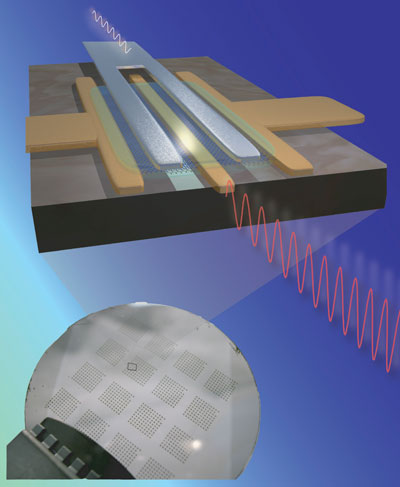A study from Tel Aviv University won an award attracting the attention of the giants of the electronic industry

Smartphones and tablets are considered the hardware of the future, but it turns out that they have some flaws. The most familiar problem is a limited RAM memory, which limits the number of applications that can be run simultaneously, and even causes the batteries to drain quickly. A researcher from Tel Aviv University recently found a creative solution to these known problems.
Doctoral student Elad Mentovich and his supervisor Dr. Shahar Richter, from the Department of Chemistry and the Center for Nanoscience and Nanotechnology at Tel Aviv University, explain that the continuous miniaturization of silicon technology creates increasing difficulty in building a large memory - mainly due to the difficulty in reducing the capacitor used to store information. Mentovich used carbon molecules called 60C to build a tiny and sophisticated memory transistor that is capable of transferring and storing energy, completely eliminating the need for a capacitor.
The molecular transistor, which can be manufactured at a size of 5 nanometers (with a channel that may be XNUMX nanometer in size), stores and sends information very quickly. The innovative development, produced in standard processes, is already ready for production in existing hi-tech facilities, and large companies in the memory industry are already showing interest in the technology. In May, Mentovich won first prize in the session on innovative materials approaches to microelectronics, at the European conference of the Materials Research Association. The basis for the technology was published in the journal Advanced Materials and Applied Physics Letters.
Closing the technological gap
According to Mentovich, mobile devices such as smartphones and tablets are the computing means of the post-PC era. The mobile devices, which are small and powered by batteries, are quickly closing the technological gap between them and the personal computer and the traditional laptop - when it comes to computing power and storage capacity. However, they suffer from a lack of RAM, the same 'random access memory' needed for the computer's regular operation, and in particular for the parallel operation of programs. RAM devices that exist today are physically large, and consume a large amount of energy, so they do not work well in mobile devices. This is meanwhile the significant advantage of stationary and mobile computers.
Already 15 years ago, the experts realized that the problem in miniaturizing electronic devices would be the physical size of the hardware needed to operate them. The idea of a smart transistor, which can eliminate the need for a capacitor, has been a technological dream ever since - and it seems that now it is coming true...
Mentovich drew his inspiration from the work of Israel Prize laureate Prof. Avraham Nitzan from the Department of Chemistry at Tel Aviv University, who proved that a molecule can simultaneously store information and electrical charge inside it, thanks to its special structure. To apply these findings to transistors, Mentovich used 60C molecules, which consist of 60 carbon atoms. He placed them inside a channel of a transistor, and created a fast and tiny transistor, capable of storing information.
The world belongs to mobiles
Mentovich believes that this technology is extremely essential in the world of mobile devices. "In 2012, major technology companies, for the first time in their history, sold more tablets and smartphones than laptops of all types," he says. "When the new technology is integrated into the smartphones and tablets of the future, they will have much more memory, close in size to the memory offered by a traditional laptop computer. With such memory it will be possible to run applications at the same time. In addition, the electrical voltage is low, so the electricity consumption will be significantly reduced, and the battery life will be longer."
The next step is to find a manufacturing facility equipped with the necessary materials to manufacture the new transistor. According to Mantovich, one of the advantages of molecular memory is that it can be produced almost anywhere - with equipment that is standard today in high-tech factories, and with the help of innovative assembly techniques developed by Mantovich himself. "The distance to implementation is not great," he states.

5 תגובות
Daniel, thank you. I managed to find the part with the 40% 🙂
It wasn't easy to filter through all this legalese, after which, I wonder if we can really expect 40% or if the millions of words before and after the 40% have the function of making this number legally and cruelly negligible...
By the way, it is important to preserve the researcher's rights, but not rush to put the cart before the horse: you need to see how this business performs after downsizing and moving to a mass production method, how much it costs to convert the facilities, and more.
I'm late to the researchers good luck.
Those who want to search for more about the study are welcome here:
http://www.tau.ac.il/~richter1/mentovich.htm
40% for researchers
For further reference (caution, regulations):
http://www2.tau.ac.il/yoets/01-003a.pdf
Eyal, this is a fascinating and charged topic, there are arguments here and there:
http://www.ynet.co.il/articles/0,7340,L-4253813,00.html
And I'm interested in what the doctoral student and supervisor will see from the success of the research beyond publication, respect and fame?
If it succeeds and breaks into the market widely, it is a lot of money. The business ways can be diverse, but still, in the bottom line, can the two guys be financially calm after the success of the technology?
I hope that more researchers are reading here who managed to succeed with research that had technological implications, as a result of which a lot of money flowed into the industry, and to hear from them as a first-hand source.